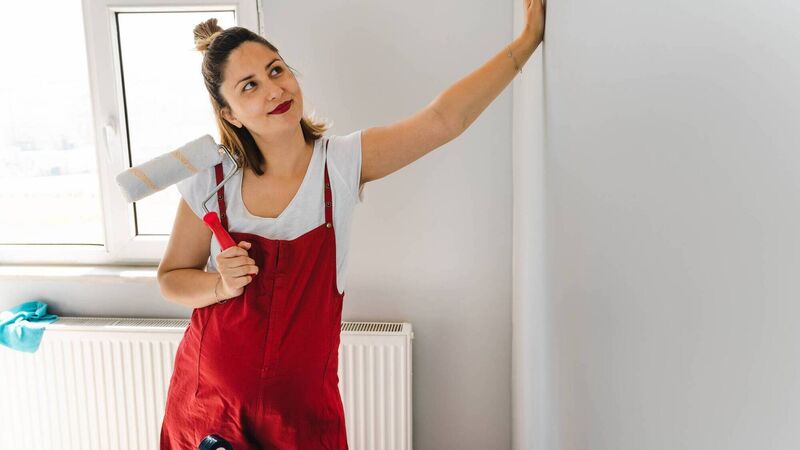Want to motivate your teen or calm down a 'wild child'? — the colours you use in their bedroom could be key

SHADES OF DIFFERENCE: The colour you paint their room can influence your child's behaviour. Picture: iStock
Amy Huberman, Rosanna Davison and Princess Eugenie are all expecting babies — and with a post-lockdown baby boom anticipated for early next year nesting instincts may be running high many others too.
A big focus will, of course, be the baby’s nursery, with choice of colour a key priority. And colour can have a significant effect even on babies, influencing everything from mood to psychical wellbeing, according to psychologist and wellbeing consultant Lee Chambers.
“Children like to see, eat and play with different colours – think of blocks and Lego, which are all primary colours,” says Chambers.
Research on the effect of colour on the psyche is relatively new, he adds. A significant piece of work done by the Wagner Institute of Colour in the US that found intense yellow in a nursery — more than any other colour — caused disruption and crying in babies.
“Research suggests colour association forms in the womb, where we’re surrounded by the colours of our mother’s insides — the light permeating through the skin creates a peach colour, so we have an association with that pastoral shade of orange,” says Chambers, who cites a small study that found decorating the room of a hyperactive child – who suffers sleepless nights — in calm pastel colours and painting the ceiling peach lead to calmer children.
If Amy, Rosanna or Princess Eugenie intend to paint their new arrival’s nursery red, they’re in poor company. A survey carried out by interior design specialists homedit.com found that, out of seven colours, red came bottom of the list with just 6% of parents opting for it. Which is a good thing — Chambers says it’s likely to increase aggression, decrease concentration and over-stimulate children.
The British-based dad of two — Myles, seven, and Annabel, six — says he and his wife chose green for their son’s nursery before Chambers had ever even researched the psychology of colour. “We felt it was a relaxing, almost regenerative colour. Green has some of the calming elements of blue and the jolly benefits of yellow. A green environment boosts wellbeing and creativity over time,” says Chambers.
And because we spent almost all of our evolution in natural spaces, green is the colour we’re used to seeing most often. “We’ve evolved to be able to pick out more shades of it, also because of where green falls on the light spectrum,” says Chambers.
Yellow, however, topped the popularity poll among the over 3,000 parents surveyed – 52% went for it, and Chambers says when it’s a neutral yellow (as opposed to a bright shade), it creates a happy aura and can increase focus and motivation.
His daughter’s nursery was a pale shade of yellow. “She wasn’t the best sleeper. But then she suffered with colic and she developed food intolerances, which were probably the root cause of her problem. Her room is still that pale shade of yellow and we have no issues – both kids sleep very well,” he says, while emphasising that psychology of colour is a very nuanced field of study.
Next up after yellow in the popularity stakes was pink, getting 37% of the votes. “It’s a popular colour for a bedroom, but not so often elsewhere – it takes some of the benefits of red and takes the edge off the stimulation, but over time it can become irritating,” says Chambers.
Purple came in third with 31% choosing it — Chambers says it can create a nice balance as it combines the fire of red with the relaxed nature of blue. Blue was fourth, at 29%. “It creates a calming atmosphere that reduces stimulation and helps children to settle.”
Orange was down the list, with 17% of parents opting for it – Chambers says it’s “full of joyful and vibrant connotations”.
But surely the effect of colour on the parental psyche should be a top consideration too? After all, baby’s sleepless nights will have mums and dads pacing the nursery floor – or that of their own bedroom – as they try to rock their bundle of joy back to sleep.
“Similar colour principles apply,” says Chambers. “A bedroom has to be a place of serenity, designed to be restful and relaxing. It has to be painted in colours that don’t stimulate activity in the mind."
Thinking about his and his wife’s bedroom, he says it’s painted a kind of pastel gold colour. “It has a little bit of richness to it but it’s not too bright. We have a very big window and when we open the curtains light shines on it and it’s a shade of yellow — it induces a feeling of a room full of sunlight. When the sun goes down and we close the blinds, it has an earthy undertone – you feel reconnected to nature and grounded when you’re there in the evenings.”
That the colour changes depending on whether natural or artificial light is shining on it — so it’s vibrant in the morning, more mellow in the evening — is something he loves about it. “I like it for the balance it brings. Colour in the bedroom has an underlying impact on how our day starts. And how it starts is the compass for how it proceeds.”
At the end of the day, he says the psychological response we have to colours is quite personal, shaped by experience and culture. “The psychology of colour is still studying the small changes it can make on humans, but it’s a small part of creating a loving environment for your children. Trust your intuition and you won’t go far wrong.”
- Yellow — The wonderful colour of neutrality. A happy aura comes from a room in the colour of the sun. The brighter the yellow, however, the more it stimulates frustration — in research yellow made babies cry more than any other colour.
- Pink — It’s calming initially and can increase compassion but over time it can become irritating, leading to a disruptive child.
- Purple — A wise and regal colour, it’s a great choice for something different. It can be tailored towards more energy or more serenity by changing the shade. It has an element of grown-up about it, which may take the childish edge off.
- Blue — A popular colour, it invokes a sense of the body cooling, which helps when children fall asleep. It’s worth being mindful of the tone — too dark can become almost gloomy and uninspiring, but too pale reduces some of the benefits.
- Green — The symbolic colour of nature, it’s the one we can see the most shades of. With its connotations of growth and the outdoors, it takes some of the happiness from yellow and some of the calming of blue. It promotes concentration and soothes the mind. However, it doesn’t motivate or inspire energy or communication.
- Orange — A joyous colour not often used but very welcoming. It’s the colour for inspiring communication if you want to promote chatter – but it can also generate underlying anxiety that decreases children’s attention.
- Red — Associated with anger and passion, it’s a highly emotive colour and likely to lead to an excitable, confident child willing to push the limits
Read More

Celebrating 25 years of health and wellbeing








